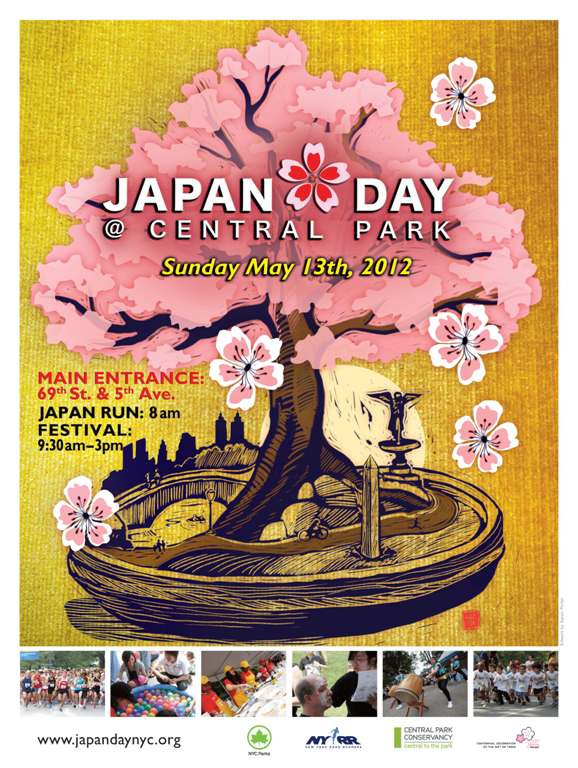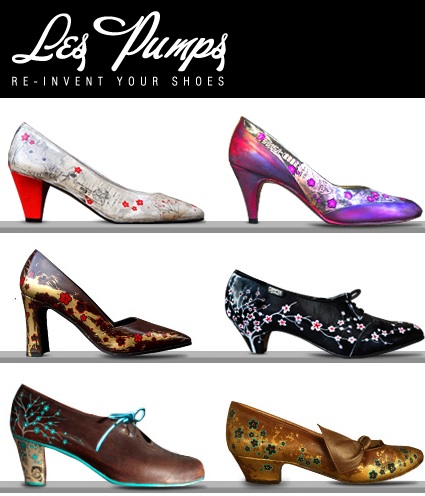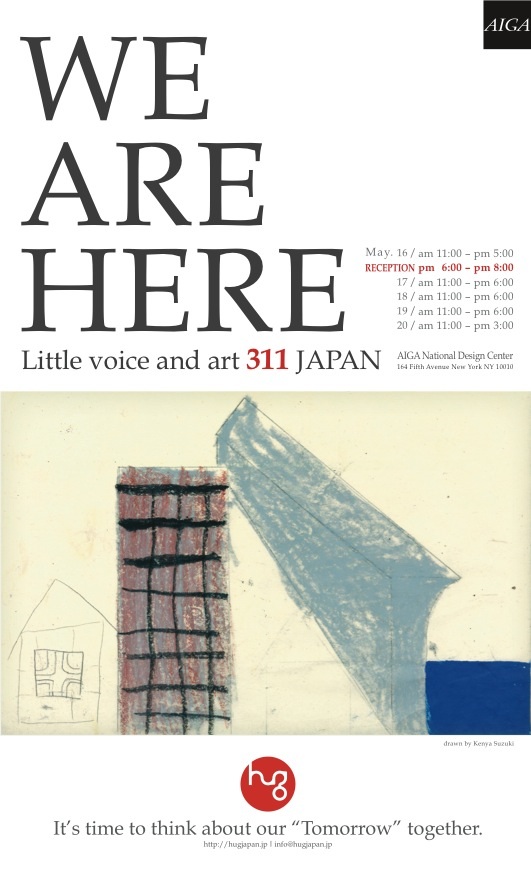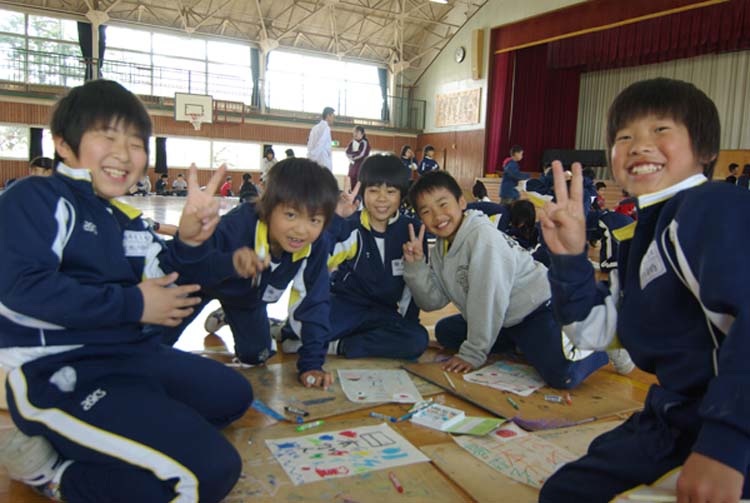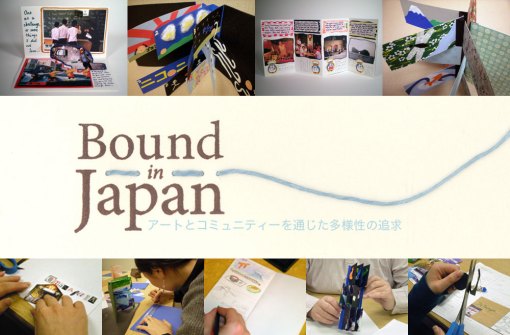JET alum wins “Japan Day @Central Park” poster contest
 Congratulations to Aaron Porter (ALT Kyoto-fu, Yawata-shi, 1998-2001), who is the 2012 winner of New York’s “Japan Day @Central Park“ poster contest!
Congratulations to Aaron Porter (ALT Kyoto-fu, Yawata-shi, 1998-2001), who is the 2012 winner of New York’s “Japan Day @Central Park“ poster contest!
From the JapanDayNYC.org website:
“Japan Day – Cherry Blossom Art Contest”
Contest Results
WINNER
To commemorate the 100th anniversary of Japan’s gift of cherry trees to the New York City, Japan Day invited visual artists to submit artwork that featured the beautiful of both cherry trees and Central Park.
Thanks to all of your support, the art contest received total of 45 submissions. All Jurors will agree that, there were a number of impressive entries that made the selection process a challenge. In fact, the Judges also awarded 5 honorable mentions, in addition to choosing a winner.
We are delighted that we can now reveal the winner of the Japan Day Cherry Blossom Art Contest — Aaron Porter and his art work!
【Japan Day 2012 Official Poster Visual using Mr. Porter’s Art Work】
From Aaron’s profile on the Japan Day NYC website:
 Aaron is originally from Chicago and received a Bachelor’s Degree in Scientific Illustration from Northern Illinois University. He began his career as a newspaper artist in South Florida in 1988 in a pre-digital world. Aaron first worked for the Sun-Sentinel in Fort Lauderdale, then the Miami Herald. While in South Florida, Aaron earned a MFA in painting at the University of Miami.
Aaron is originally from Chicago and received a Bachelor’s Degree in Scientific Illustration from Northern Illinois University. He began his career as a newspaper artist in South Florida in 1988 in a pre-digital world. Aaron first worked for the Sun-Sentinel in Fort Lauderdale, then the Miami Herald. While in South Florida, Aaron earned a MFA in painting at the University of Miami.
Shortly after finishing his course work, he was accepted into the Japan Exchange and Teaching Program the summer of 1998. He taught English in four junior high schools in Yawata City (Kyoto Prefecture) and still to this day considers it the most exciting three years of his life. While in Japan, he spent his spare time getting to know Japanese culture and painting. His paintings during this period were most often about Japanese culture. During his time in Japan, he had a painting exhibition at the Kyoto International Center in Kyoto Station as well as a number of other small shows in coffee houses and wherever he could get his work shown.
Aaron returned to the States the summer of 2001 and began his new career in newspapers at The Journal News in White Plains, New York. Presently, Aaron is a part-time digital art instructor at the Bronx Community College as well as a freelance graphic artist and illustrator.
Aaron is married to a Japanese woman from Fukuoka whom he met in New York City after he returned from Japan. They live in Up State New York, visit NYC often and travel to Japan each year to visit her family. Much to his wife’s disappointment he speaks very little Japanese.
WIT Life #197: DC Sakura Matsuri, Part 2
WIT Life is a periodic series written by professional Writer/Interpreter/Translator Stacy Smith (Kumamoto-ken CIR, 2000-03). She starts her day by watching Fujisankei’s newscast in Japanese, and here she shares some of the interesting tidbits and trends together with her own observations.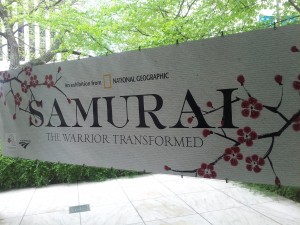
Today is the big parade to celebrate the centennial sakura matsuri, but unfortunately all the blooms are long gone. However, the festival goes through the end of the month, so for those who find themselves in DC there are plenty of Japan-related activities to keep you entertained. I had a chance to sample many of them this week, the first of which I’d recommend being the National Geographic Museum’s samurai exhibit running through early September.
It shares the history of how the now legendary cherry trees made their way to DC, as well as displays unique items such as swords and armor that were gifted from Read More
WIT Life is a periodic series written by professional Writer/Interpreter/Translator Stacy Smith (Kumamoto-ken CIR, 2000-03). She starts her day by watching Fujisankei’s newscast in Japanese, and here she shares some of the interesting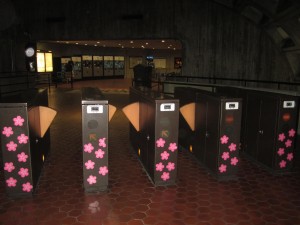 tidbits and trends together with her own observations.
tidbits and trends together with her own observations.
I’m down in DC to begin a new business trip, and was thrilled when I found out my assignment would coincide with the famous Sakura Matsuri. This year is extra special as it marks the 100th anniversary since the 3000+ trees were gifted from Japan to the U.S. Even the Metro gets into the spirit, as you can see with their turnstile decorations. Due to the warm weather it is doubtful that the blossoms will last until the conclusion of the festival at the end of the month, but I’m hoping to do some hanami while I’m here.
On another Japa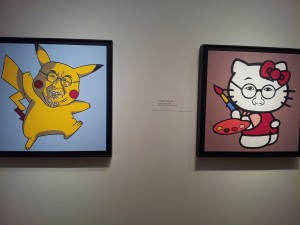 n-related note, today I went to see an interesting exhibit at the National Portrait Gallery entitled “Asian American Portraits of Encounter.” It features several different Asian American artists, including three Japanese. One is Satomi Shirai based in New York, the second is Shizu Saldamando based in California, and the last is Roger Shimomura based in Read More
n-related note, today I went to see an interesting exhibit at the National Portrait Gallery entitled “Asian American Portraits of Encounter.” It features several different Asian American artists, including three Japanese. One is Satomi Shirai based in New York, the second is Shizu Saldamando based in California, and the last is Roger Shimomura based in Read More
LAST CHANCE – “Fall Flowers of Japan” @ NY Botanical Garden until 10/30/2011
Carolyn Brooks (Ishikawa-ken, Kanazawa, 2006-11) is co-author of the blog MadSilence–a cross-cultural blog written with her father–and a current culture/education related job-seeker in the NY area available for full-time or consulting work.
Feeling a bit homesick for the full moon, momiji and manju that are signs of fall in Japan? Despair not, for 4 days remain of the wonderful “Fall Flowers of Japan” display at the New York Botanical Garden. It will continue until Sunday, October 30th, 10AM to 6PM, and costs (a completely worthwhile) $20 to see. The main focus of the display is kiku, chrysanthemums. They have dozens of varieties to see, including traditional shapes and colors from Japan trained into waterfalls or bridges, and new strains bred in American which look like bird’s nests and exploding stars.

These mums were bigger than a grapefruit, and were so glossy and translucent that they should be made of spun sugar!
Les Pumps: Japan-inspired Shoe Art
by Lee-Sean Huang (ALT, Oita-ken, 2003-06). Lee-Sean is an artist, designer and educator based in New York City. He is the webmaster of JetWit and JETAANY. His new Art & Design Observer series features profiles art, design, and culture with a Japanese flavor.
Les Pumps is a collection of handmade art by the Barcelona-based Brazilian artist Caio de Paula Marques that uses vintage women’s shoes as 3D canvases. Caio decorates the shoes with hand-painted details and applies old manga art as a collage. The first Les Pumps collection is called “Sakura Vintage,” and Caio cites Japan as a major influence for his creative work. Are there any JET visual artists out there whose work has been influenced by Japan? Let us know in the comments, and we can feature your work here on JetWit.
According to the artist:
Les Pumps was born out of the need of creating an artistic project, in a more old fashion way, that involved manual crafts and to have a little break from using mainly digital tools as I have done as a graphic designer in the past years.
So in the search for interesting structures, aiming to work in a three dimensional way, and being a shoe lover myself, such fetishistic object of the feminine world seemed the perfect canvas for my art work.
Many hours have been put into each pair, from the investigation and purchase of the shoes, through which I´ve learned a great deal (now I can tell the difference between a pair of pumps from a pair of stilettos) and the many steps of execution till the final piece is ready, an average of 15 hours is needed.
For my first collection, the main motif has been SAKURA (meaning cherry blossom) so full of symbolism in Japan, reflecting the great interest I’ve always had towards this country and its culture ever since I can remember.
Perhaps the most innovating about this collection has been the use of COLLAGE, technique that allows the creations of different contexts and in this case, also recycles other artist’s works, which also relates to the concept of Vintage. Once more, the Nipponic culture is present as the paper I use is actually from 80’s manga.
VINTAGE SHOES have been my choice, as they convey history and strengthen the artistic value and the concept of uniqueness.
JQ Magazine: Art Review – ‘Fiber Futures: Japan’s Textile Pioneers’ at Japan Society
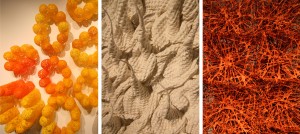
From left to right: 'Feel the Wind' (2010), by Fuminori Ono; 'Birth' (2011) by Hitomi Nagai; 'Su no hana' (Nest Flowers) (2011) by Takaaki Tanaka. (Vlad Baranenko)
By Vlad Baranenko (Saitama-ken, 2000-02) for JQ magazine. Vlad is an avid photographer.
Opening this week at New York’s Japan Society is the exhibit Fiber Futures: Japan’s Textile Pioneers, which showcases the works of Japanese textile masters and explores the ever evolving relationship between traditional fabric manufacturing and the uses of unconventional technology and materials to create awe-inspiring works of art. To commemorate the opening of the gallery and the designation of the Japan Society building as a city landmark, a special preview event was held on Sept. 14 with many of the artists in attendance along with an exhibition walkthrough from gallery director Joe Earle.
Originally conceived in 2007, the project received approval following this year’s devastation in Japan, and is jointly presented by Japan Society and the International Textile Network Japan in collaboration with Tama University. According to Japan Society, the collection of 35 works on display was thoroughly selected by a special committee to showcase the work of 30 contemporary masters of a movement originally envisioned in the 1950s to “reflect the fecundity of the Japanese artistic tradition and ingenuity.” Since many of the pieces had to make a long journey from Japan to New York, unique containers had to be meticulously designed for each piece to preserve the artist’s intended presentation and allow the viewer to fully appreciate each work.
To simply describe the collection as a stunning example of creativity and the profound Japanese insight into the coexistence of nature and man would not be enough to credit the artists on display. The exhibition explores such themes as the passage of time and seasons just to name a few. While many of the works are composed of traditional materials such as silk and washi paper, modern materials such as stainless steel, vacuum deposited aluminum, and complex chemical dyes are also added to create three-dimensional enchanting expressions.
Signs of a setsuden summer
Posted by Tom Baker (Chiba-ken, 1989-91), coauthor of The Sushi Lover’s Cookbook and Tokyo Chic and contributor to Time Out Tokyo and Time Out Shortlist Tokyo. He blogs as “Tokyo Tom Baker.”
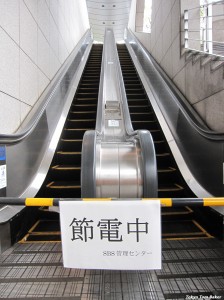 “Setsuden,” or conserving electricity, has become a huge buzzword in Japan as the weather heats up and many nuclear power plants remain shut down. Many businesses have put up signs explaining their own setsuden activities and asking the public to join in.
“Setsuden,” or conserving electricity, has become a huge buzzword in Japan as the weather heats up and many nuclear power plants remain shut down. Many businesses have put up signs explaining their own setsuden activities and asking the public to join in.
Recently I have been been photographing setsuden signs around the Tokyo area for my blog.
Some of the signs are very simple and functional, like the message seen here on a closed escalator at a train station, which simply says, “Setsuden-chuu.”
Others are clever pieces of writing and/or graphic design.
I have a gallery of signs here, as well as explanations of my picks for the best-designed sign here and the best slogan here.
Earthquake Support Event: WE ARE HERE – Little voice and art 311 Japan (NYC)
Posted at the request of CLAIR New York:
WE ARE HERE – Little voice and art 311 JAPAN is an exhibition of messages from Japanese children of areas affected by the disaster as well as photos of the area. The exhibition is being held at the AIGA Gallery in New York on 22nd St and 5th Avenue in Manhattan from today through May 20. They are also collecting messages from visitors to those children.
WIT Life #167: Japan and War as Seen Through the Lens of Film
WITLife is a periodic series written by professional Writer/Interpreter/Translator Stacy Smith (Kumamoto-ken CIR, 2000-03). She starts her day by watching Fujisankei’s newscast in Japanese, and here she shares some of the interesting tidbits and trends together with her own observations.
Recently I had the chance to see two films from 2010 that examine the issue of Japan and war. One was Anpo: Art x War which was screened at Columbia University last week, and the other is Caterpillar currently being shown at the IFC Center through this Thursday. The former is a documentary directed and produced by Linda Hoaglund, and the latter is a film made by the director Koji Wakamatsu of United Red Army fame (shown at Japan Society a few years ago and coming to IFC later this month).
Anpo uses a mixture of paintings, photos, anime, films and music by Japanese artists to Read More
Event: Two Artists, Two Expressions
Author Suzanne Kamata (Tokushima-ken, 1988-90) who also serves as the Publicity Assistant for the Society of Children’s Book Writers and Illustrators in Tokyo, shared the following:
The Society of Children’s Book Writers and Illustrators presents
Two Artists Two Expressions
Colored Pencil Workshop with Katsuya Takahashi and Daniel Schallau
Time: Saturday, May 21, 2011, 6:30-8:30 p.m.
Place: Tokyo Women’s Plaza, Audiovisual Room
5-53-67 Jingumae, Shibuya-ku, Tokyo
(by the Children‘s Castle and United Nations University;
for a map see www.scbwi.jp/map.htm)
Fee: SCBWI members 1,000 yen; nonmembers 1,500 yen
RSVP: Please reserve by May 20 by sending an e-mail to info@scbwi.jp
This event will be in English and Japanese.
Please join us for an evening workshop led by two master colored pencil children’s book illustrators followed by Q&A.
Katsuya Takahashi will introduce and demonstrate the basic properties and techniques of colored pencils that give his illustrations a unique look and feel. In the second half of his workshop, everyone will have the chance to experiment with the techniques that Takahashi has shared. Please bring a set of twelve or more colored pencils, some paper and an eraser.
Daniel Schallau will focus on the techniques he uses to draw cool winter scenes. Have you ever wondered how to draw snow in night scenes? Just use white? Think again. Schallau’s secrets might surprise you. This part of the workshop will offer the opportunity, for those interested, to try out some of Schallau’s tips. Please bring a range of blue colored pencils and yellow, orange and red pencils. Paper and pencil sharpeners will be provided.
Katsuya Takahashi (http://homepage3.nifty.com/katz-t/) Born in Kyoto, colored pencil artist Katsuya Takahashi studied in the Faculty of Art at Kyoto Seika University. After graduation, he became a freelance illustrator, and his work has been widely recognized in newspapers, books, magazines, and commercials. “Hyper burnishing” is how he describes his colored pencil technique. The rich hues and luminous glow of his illustrations are the result of deep layers of colors. Now a resident of Tokyo, he has held exhibitions every year since 1998. Takahashi works both in Tokyo and the Kansai area and is the author/ illustrator of the picture book, Hora utaga kikoeruyo (Listen, I Hear a Song; Builder Buch).
Daniel Schallau (www.danielschallau.com) After working for various architecture firms in the U.S., Daniel Schallau traveled to Tokyo where he now works as an English teacher and an author/illustrator. People often find it difficult to believe his drawings are actually created with colored pencils, insisting instead that they must be done with a computer. His picture book Come Back Soon (Houghton Mifflin Harcourt) was published in 2009. Schallau specializes in intricately drawn worlds inhabited by elephants, penguins, whales, bears, snowmen, rabbits and more.
JapanGanbare: Messages of encouragement and support through manga art!
A thoughtful approach to supporting Japan through original and creative images by manga fans:
Send a message of encouragement and support through your own manga art!
漫画を使って日本を応援しましょう!
WIT Life #157: Bye Bye Kitty!!!
WITLife is a periodic series written by professional Writer/Interpreter/Translator Stacy Smith (Kumamoto-ken CIR, 2000-03). She starts her day by watching Fujisankei’s newscast in Japanese, and here she shares some of the interesting tidbits and trends together with her own observations.
Last week I had the opportunity to attend the opening for the Japan Society’s newest exhibit, Bye Bye Kitty!!! The title refers to opposition towards the domination of Japan’s kawaii-ness, the idea of cuteness that has become Japan’s major export as represented by Hello Kitty. It features 16 artists, many of them quite young and not household names, and their interpretation of this concept. I was particularly drawn in by the intricacy of the works of 38-year old Manabu Ikeda, whose pen and ink masterpieces were incredibly detailed and required several minutes of close examination to take in all of their elements.
Equally interesting was the large-scale Read More
Art in the (Japanese) Social Sphere
Thien-Kieu Lam is an artist who is producing Bound in Japan. Bound in Japan is a community book art project that aims to promote awareness about diversity in Japan and enhance intercultural understanding by engaging native and non-native residents in the creation and sharing of book art.
Here, Kieu discusses the motivation behind Bound in Japan. To read the full article, which includes her insights on the power of the individual and a guide to turning a personal vision into reality, check out the blog Shinpai Deshou.
Japan, quite frankly, was an unexpected twist in my life. As an ethnic Vietnamese American who graduated with a degree in fine arts and a second major in Mandarin Chinese, I certainly had my sights on Asia, but Japan was always on the periphery. Japan didn’t really register on my radar until I was a college senior facing that daunting question mark: THE FUTURE. I had always dreamed of living abroad, and one day a friend suggested that I apply for the Japan Exchange and Teaching (JET) Program. I did and it was a fateful decision. It was the beginning of a lifelong relationship.
After three years of teaching English in Kagoshima and four years of working at the Embassy of Japan in Washington, DC, I’m ready to take this relationship to a different level. I’m going back to my roots—the arts—and crossbreeding it with social activism.
My parents are immigrants. I know very well the kind of challenges my parents have faced and continue to face during these thirty odd years. I myself have faced similar challenges while living in Japan. I had never expected to fall in love with Japan. It made me think about what it would be like if I chose to settle there, to make Japan my new—and permanent—home.
Every time I go to Japan, it doesn’t feel like I’m traveling. It feels like going home. I have numerous Japanese friends, and for the most part, I can confidently navigate the physical and social geography. But that doesn’t mean it’s easy to live in Japan.
Japan has been a mostly homogenous society for centuries. It hasn’t had to think much about the less than 2% of the population who are non-native residents. And it shows. There’s a lack of integration. A lack of infrastructure. Even now, immigration policy continues to take a backseat despite the steady increase in immigration over the years. Despite the fact that opening up immigration is one of the few viable solutions to the current challenges presented by Japan’s changing demography. Lots of words are being said, but where’s the action?
Local communities are taking matters into their own hands. There are many organizations whose mission is to assist foreign residents with language, culture, and legalities and who seek to enhance intercultural understanding. This makes me very hopeful. I believe that any sort of social change will begin locally at the grassroots level. It has to begin with public consciousness.
Art can play a role in this. Art, after all, is about expression. It’s a way to communicate. This is the goal of Bound in Japan. Participants will be able to engage in an educational and enjoyable activity that allows them to share their stories with others. Through the process of creating art about their experiences in an adopted homeland and the act of sharing it with others, there are many opportunities to learn about each other, to start new dialogues, and to engage in community building.
Bound in Japan is a collaborative art project. Its success depends on the active participation of the community. This success can be defined as the personal enrichment of individual lives as well as the enrichment of an entire community.
I know that there are many people like me, who love and consider Japan a home. There are many ways you can support Bound in Japan. A project like this requires a significant budget. Consider making a donation to the Bound in Japan IndieGoGo campaign. Know of an organization in Japan that would like to participate in the project? Let me know. Are you living in Japan right now and would like to take part in Bound in Japan? I would love to hear from you.
Learn more about Bound in Japan: http://boundinjapan.com
Contact Kieu: tknlam@gmail.com
Follow Kieu and Bound in Japan on Twitter: @KieuLam
 Info courtesy of Diana Lee, President of AsianInNY.com. Diana is handling performances for the 32nd Asian/Pacific American Heritage Festival in New York.
Info courtesy of Diana Lee, President of AsianInNY.com. Diana is handling performances for the 32nd Asian/Pacific American Heritage Festival in New York.
The Asian/Pacific American Heritage Festival is a free, day-long celebration of Asian/Pacific Americans. On May 8th, 2011, from noon-6pm, performing groups from the New York tri-state area will take the stage in front of an audience of over 8,000 in Union Square, Manhattan.
We are currently seeking submissions for:
- Performances from artists and companies working in music and/or dance including folk, traditional, and contemporary expressions.
- Must be appropriate for a family oriented 20-30 minutes performance on an outdoor stage.
The event has a history of high media coverage featured in the New York Times, Newsday, the Village Voice, Time Out magazine, NY1 News, and many ethnic papers.
We will have a merchandizing table for performers who participate in this festival to sell their items or place their promotional materials (flyers/posters).
To submit registration or auditions for performances, please visit our registration site at: http://bit.ly/etkYAP
Deadlines:
Performances Submissions: Friday, February 18, 2011
For more information regarding the festival: www.capaonline.org
If you have any questions, please don’t hesitate to contact me here or at info [at] ASIANinNY.com.
Thank you,
Diana Lee
VP of Performance of APA Heritage Festival
WIT Life #152: Kaga Maki-e
WITLife is a periodic series written by professional Writer/Interpreter/Translator Stacy Smith (Kumamoto-ken CIR, 2000-03). She starts her day by watching Fujisankei’s newscast in Japanese, and here she shares some of the interesting tidbits and trends together with her own observations.
Recently I had the opportunity to interpret for a delegation from Kanazawa that was here to promote the city in general and especially its ancient craft of 蒔絵 (maki-e), a lacquerware technique that uses silver and gold powder. This art form actually originated in Kyoto which has its own style known as Kyo Maki-e, but the Kanazawa version is called Kaga Maki-e, Kaga referring to the area of Kanazawa where it originated. This picture, courtesy of fashion blogger Alice Chin, shows two delegation members at the ribbon cutting ceremony for the new Kaga Maki-e display.
On the left is native New Yorker and long-term Kanazawa resident Evelyn Teploff-Mugii, a designer who has modernized the thousand year old maki-e process to make breathtakingly beautiful accessories. Her Evelyn Claude line will be offered in the US for the first time. To her right is Read More

